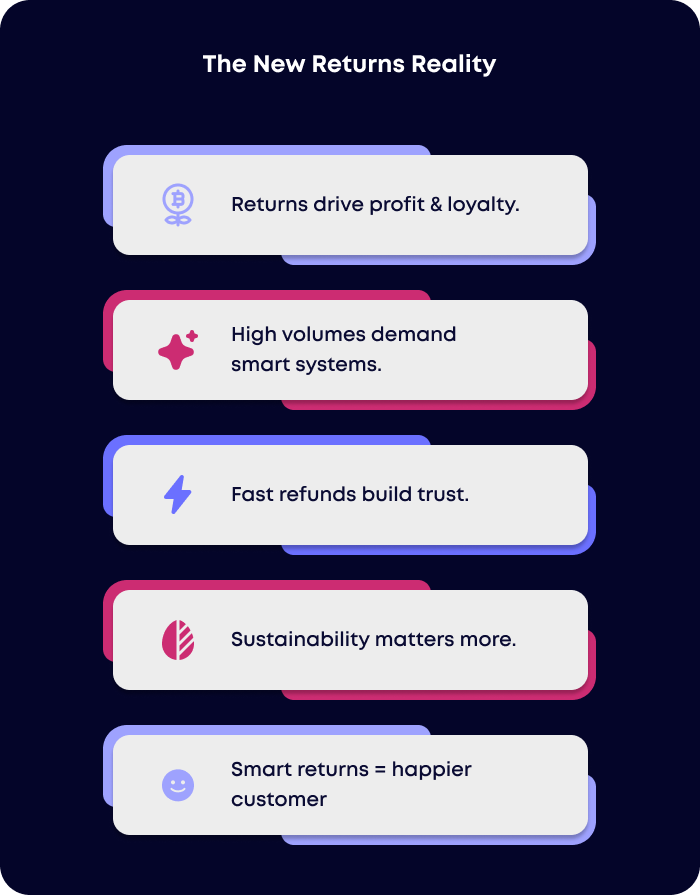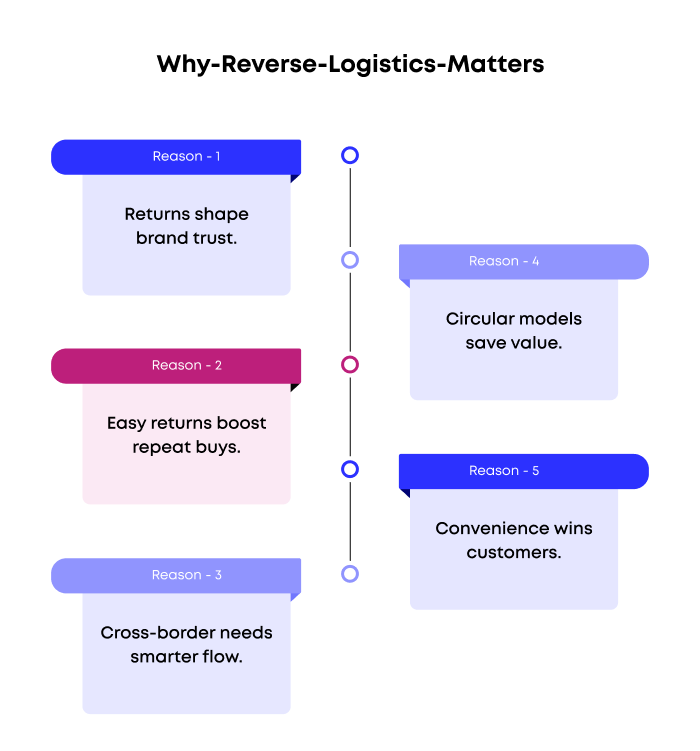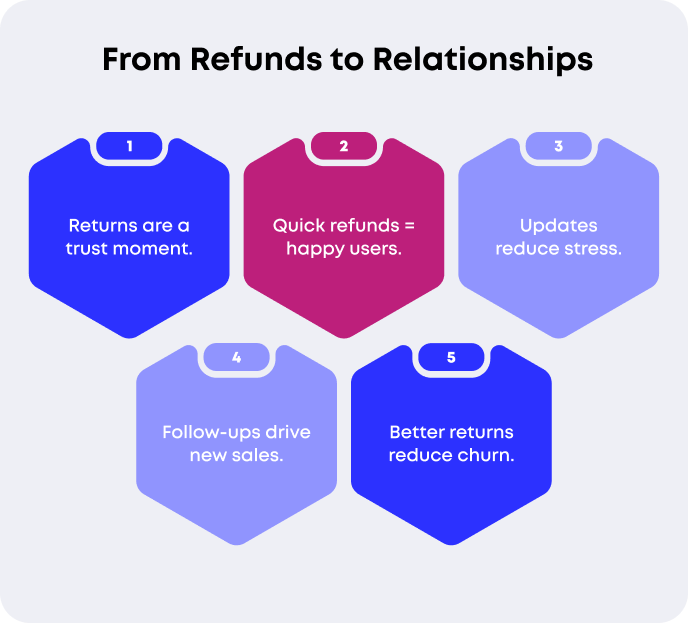Introduction
In today’s global e-commerce landscape, the sale doesn’t end when a product is delivered, it’s just entering the next critical stage: returns. What many brands once treated as a logistical inconvenience or unavoidable cost is now being recognized as a strategic opportunity.
Think about it: When was the last time a return process made you feel more confident in a brand? That’s the new benchmark.
Reverse logistics, which encompasses the process of managing product returns, restocking, refurbishing, or recycling, has evolved into a defining factor in how customers perceive a brand’s reliability and service quality.
For decades, retailers focused primarily on optimizing the forward supply chain, speeding up delivery times, reducing costs, and enhancing visibility. However, as global e-commerce matures and customer expectations rise, the post-purchase experience is becoming just as important as the purchase itself. Modern consumers now judge brands not only on how quickly they deliver but also on how smoothly and transparently they handle returns, refunds, or replacements.
A frictionless returns process communicates something deeper than efficiency, it signals trust, accountability, and respect for the customer’s time and investment. When a brand handles returns with clarity and empathy, it transforms a potentially negative experience into one that reinforces loyalty. In a competitive market where acquisition costs continue to rise, ensuring a smooth reverse logistics process can directly impact customer lifetime value.
Did you know?
Over 30% of all e-commerce orders result in a return, yet 92% of customers say they would buy again if the return process is simple and hassle-free.
When brands treat returns as part of the customer experience — not just a cost center — they create a loop of continuous trust-building. Every transparent communication, every timely refund, and every well-managed return adds another layer to customer satisfaction. As a result, reverse logistics becomes not only a reflection of operational excellence but also a powerful driver of brand loyalty in global commerce.
1. The New Reality: Returns as a Strategic Asset

Reverse logistics, the process of managing product returns, repairs, and recycling, has evolved from being a mere operational cost center into a strategic differentiator in modern commerce. As global e-commerce matures, companies are realizing that the way they manage returns has a direct impact on profitability, customer retention, and brand image.
Several key forces are driving this transformation.
First, rising online return rates, particularly in categories like apparel, electronics, and beauty, have made returns management an unavoidable part of e-commerce operations. With consumers unable to physically test or try products before purchase, return volumes naturally increase.
Second, customer expectations for instant resolutions, such as quick refunds, easy exchanges, and transparent communication, are redefining what good service looks like. And third, the growing global emphasis on sustainability has pushed brands to rethink how they handle returned items, focusing on recycling, reusing, or refurbishing rather than disposal.
Forward-thinking companies are beginning to see returns not as a financial burden but as an opportunity to create positive post-purchase experiences. Every well-managed return can enhance customer confidence and strengthen trust.
Ask yourself:
How does your brand handle returns today, as a post-sale problem, or as a customer loyalty opportunity?
2. Why Reverse Logistics Matters More Than Ever

In today’s global marketplace, returns are no longer just a logistical task, they are a strategic function that directly influences brand reputation and operational performance. When executed effectively, reverse logistics can reduce waste, reclaim value from returned goods, and create memorable customer experiences that foster repeat purchases.
Several trends are accelerating this shift. One major driver is convenience. According to industry research, 80% of consumers say that an easy and transparent returns experience influences their decision to buy again from the same brand. In an era where customer loyalty is fragile, simplifying the return journey can make all the difference.
Secondly, as e-commerce expands across borders, cross-border logistics adds new layers of complexity. International returns often involve customs documentation, local regulations, and longer transit times. To overcome these challenges, many global retailers are investing in regional warehousing and local return processing centers to speed up turnaround times and reduce costs.
Finally, the rise of circular economy practices is redefining the role of reverse logistics altogether. Rather than discarding returned items, forward-thinking brands are recovering value through refurbishment, resale, or recycling, aligning environmental responsibility with business efficiency.
💬 Pro Tip:
Consider integrating return drop-off points or automated locker systems in key markets. These solutions not only enhance customer convenience but also reduce transportation costs and carbon emissions, creating a win-win for both your brand and the environment.
3. From Refunds to Relationships: Returns as Loyalty Drivers

In the customer journey, the return experience often represents a critical “moment of truth.” It’s the point at which a brand either reinforces its reliability or erodes customer trust. A poorly managed return, one marked by confusion, delays, or hidden fees, can undo months of positive brand perception. On the other hand, a well-executed, transparent process can turn disappointment into delight, transforming one-time buyers into long-term loyalists.
Leading brands are recognizing that returns are not just a logistical step, but a relationship-building opportunity. Here’s how they’re reshaping the experience:
- Transparent communication: Real-time updates on the return status, from pickup to refund confirmation, reassure customers and reinforce the brand’s credibility.
- Instant refunds or store credits: Today’s shoppers expect speed. Offering immediate resolutions, whether through automated refunds or instant store credits, creates a sense of efficiency and respect for the customer’s time.
- Personalized follow-ups: The best brands don’t let the relationship end after the refund. Sending personalized recommendations or incentives post-return helps turn an inconvenience into a positive interaction, increasing the likelihood of a future purchase.
📈 Example in Action:
A global beauty brand achieved an 18% reduction in customer churn after implementing a “hassle-free returns” portal integrated directly with its fulfillment partner. The initiative allowed customers to track returns in real time, select preferred refund methods, and receive proactive updates, effectively transforming what used to be a friction point into a loyalty driver.
The takeaway is clear: returns can either cost you a customer or win you one back. In a world where expectations for speed and transparency are higher than ever, brands that handle returns gracefully are the ones customers remember, and return to.
4. The Role of Regional Warehousing in Reverse Logistics

As global e-commerce continues to expand, regional warehousing has become an essential element of efficient and sustainable logistics, not just for outbound shipping, but increasingly for reverse logistics as well. Many businesses focus on how regional hubs shorten delivery times and reduce cross-border complexities, but the same infrastructure also provides immense value when it comes to processing returns.
By handling returns closer to the customer, regional hubs enable brands to:
- Re-stock faster for resale: Quick inspection and restocking of returned items help minimize inventory loss and accelerate product availability, which directly impacts revenue.
- Lower international shipping costs: Processing returns locally avoids the high costs and environmental impact of sending products back across borders.
- Reduce carbon footprint: Fewer long-haul shipments mean lower emissions, helping brands meet sustainability goals while improving operational efficiency.
Think of your regional hub as a two-way street — not only delivering products outward but also welcoming them back efficiently. Regional hubs don’t just speed up outbound deliveries, they streamline reverse logistics too. By processing returns locally, brands can:
Case Example:
Filuet’s smart fulfillment infrastructure exemplifies this approach. By enabling brands to manage both outbound and inbound logistics seamlessly across multiple markets, Filuet helps global businesses close the loop on returns, turning what was once a logistical burden into an integrated, value-driven process.
5. Technology: The Engine Behind Smarter Returns

The future of returns management lies at the intersection of data intelligence, automation, and seamless system integration. As the volume of returns grows, brands can no longer rely on manual processes or disconnected workflows. Instead, modern reverse logistics is powered by advanced technology that helps businesses stay proactive, not reactive.
Key enablers include:
- AI-driven return forecasting: Machine learning models analyze past purchase and return data to predict return volumes by region, category, or season, helping brands optimize inventory and labor allocation before the rush hits.
- Real-time visibility through integrated systems: Connecting warehouse management systems (WMS), order management platforms (OMS), and transportation management tools provides a single source of truth for every return. This visibility ensures transparency both for brands and their customers.
- Automated decision-making: Intelligent systems can instantly determine whether a returned product should be restocked, refurbished, recycled, or discarded, reducing manual intervention and saving time.
- Customer-facing dashboards: Self-service portals that track the entire return journey, from initiation to refund, enhance the customer experience and reduce support workload.
💡 Did you know?
Brands using integrated reverse logistics systems have been shown to cut return-related processing costs by up to 25%, while simultaneously improving customer satisfaction and brand perception.
6. Sustainability and Circular Value

In an era where customers are increasingly mindful of environmental impact, reverse logistics has evolved into a key enabler of the circular economy. What once was a linear model, products moving from production to consumer to disposal, is now being replaced by a circular one, where goods are reused, repaired, refurbished, or recycled to extend their lifespan and minimize waste.
For global e-commerce brands, sustainability is no longer just a corporate responsibility, it’s a consumer expectation and a brand differentiator. Shoppers today are paying closer attention to how companies handle the afterlife of their products, from packaging to returns management. According to McKinsey, more than 60% of consumers say that sustainability is an important factor in their purchasing decisions, and that sentiment extends beyond the checkout page.
Reverse logistics plays a critical role in meeting these expectations. By designing efficient systems to collect, inspect, and repurpose returned products, companies can reduce their environmental footprint while also recovering value that would otherwise be lost.
Sustainable practices include:
- Refurbishing or repairing returned products:
Items that can be restored to “like-new” condition are tested, repaired, and reintroduced into circulation, whether as certified refurbished items or outlet store inventory. This not only keeps products out of landfills but also helps offset manufacturing costs and energy usage. Leading electronics and apparel brands have already built specialized refurbishment programs that allow them to recapture up to 70% of a product’s value. - Repackaging for resale:
Gently used or open-box products are inspected, cleaned, and repackaged for resale — often through online clearance sections or dedicated resale platforms. This strategy appeals to price-sensitive or sustainability-minded shoppers, turning returns into new revenue streams while keeping waste minimal. - Partnering with recycling firms:
For products that can’t be reused, responsible recycling ensures that materials such as plastics, textiles, and metals are recovered and repurposed. Brands are increasingly forming partnerships with recycling companies and non-profits to handle non-salvageable items ethically and transparently. - Eco-friendly packaging and transport:
Sustainable reverse logistics also involves rethinking how returns are shipped. Using recyclable packaging, consolidated return shipments, and carbon-offset delivery options reduces emissions and aligns the entire returns process with broader ESG goals.
🌱 Takeaway:
Every return can tell a sustainability story. When brands communicate how they refurbish, recycle, or responsibly dispose of returned goods, they don’t just protect the environment, they reinforce their values and connect emotionally with eco-conscious customers.
In this way, reverse logistics becomes more than an operational process; it’s a brand statement. By embedding sustainability into every step of the returns journey, companies can simultaneously improve profitability, customer perception, and environmental impact.
7. How Filuet Supports Reverse Logistics Excellence

Filuet’s end-to-end fulfillment ecosystem is designed with one core principle in mind: transparency and efficiency, in both directions of the supply chain. As brands expand globally, handling returns across multiple regions can become complex and costly. Filuet bridges this gap with an integrated infrastructure that makes reverse logistics as smooth and reliable as outbound fulfillment.
What Filuet offers:
- Local and regional warehousing for efficient return processing:
By maintaining strategically located warehouses across key international markets, Filuet enables brands to process returns locally. This minimizes transit time, cuts shipping costs, and allows faster re-stocking for resale or redistribution. - Technology integration with e-commerce systems:
Filuet connects directly with leading e-commerce platforms and order management systems, allowing for automated return initiation, real-time tracking, and data synchronization. This means brands always have full visibility of product movements, from the moment a customer triggers a return to when it’s back in inventory. - Real-time data visibility for brands:
Through Filuet’s advanced reporting tools, companies can analyze return rates, identify recurring issues (such as product defects or sizing problems), and make informed improvements to products or processes. These insights help reduce future returns and enhance customer satisfaction. - Experience managing complex reverse logistics networks for global clients:
With decades of experience supporting industries ranging from wellness and nutrition to consumer electronics, Filuet has mastered the art of cross-border returns. Their expertise ensures compliance with customs regulations, optimized route planning, and seamless coordination between local and central hubs.
Result:
A smoother, faster, and more sustainable returns experience that not only reduces operational friction but also reinforces trust between brands and customers. By transforming reverse logistics into a strategic asset, Filuet helps global businesses close the fulfillment loop, turning every return into an opportunity for efficiency, transparency, and loyalty.
Conclusion
As global e-commerce continues to expand, reverse logistics is becoming a critical pillar of long-term success. The next generation of customer-centric brands will be defined not by how fast they deliver, but by how effortlessly they handle what comes back. The ability to process returns quickly, issue refunds transparently, and reintegrate products into the value chain sustainably will separate industry leaders from the rest.
This is where partners like Filuet make a real impact. With its global network of regional warehouses, advanced fulfilment technology, and expertise in handling complex logistics flows, Filuet helps businesses transform the returns process from a cost center into a strategic growth driver. By integrating data visibility, automation, and sustainability into every step of reverse logistics, Filuet enables brands to deliver smoother customer experiences while maintaining operational efficiency.
Ultimately, mastering reverse logistics isn’t just about reducing costs — it’s about building relationships. With the right fulfilment partner, businesses can turn every return into an opportunity to reinforce trust, strengthen loyalty, and showcase their commitment to responsible commerce.
.webp)














